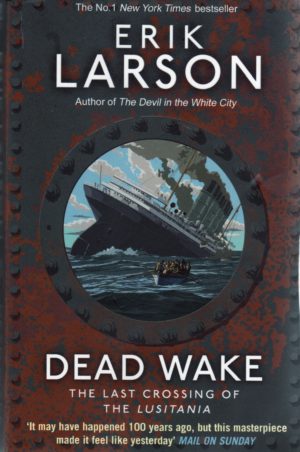
We all know that the sinking of the Lusitania prompted President Woodrow Wilson to enter WW I, right? I mean, when I picked up this book, delivered to me by a friend, and began to read, the first thought that popped into my brain was I know this stuff. I can’t imagine it will be anything close to riveting. I was wrong. Larson’s use of novelistic prose makes this back and forth revelation of the Cunard Line’s flagship’s final voyage a fascinating read.
Larson builds the suspense and his story by exchanging scenes between Captain Turner, the skipper of the doomed ocean liner, and Captain Schweiger, the commander of U-20, the German submarine that ultimately strikes the fatal blow, as well as interspersed perspectives from Winston Churchill (head of Britain’s admiralty at the time) and other players, including love-struck widower, Woodrow Wilson. The callousness of both Cunard officials (decreeing that Turner could not run his ship at full speed, thereby saving coal but diminishing his ability to outrun sluggish submarines) and the admiralty (who had ample warning U-20 was in the area and on the hunt) leads to the death of over a thousand passengers and crew. Larson builds and builds the suspense of the last voyage of the Lusitania until this scene, a moment of happenstance and luck (good for the Germans, bad for Turner and his crew), brings the sub and the liner together:
U-20 moved through a blue-on-blue morning. The fog was gone, the sky was empty of clouds, the sea was still. Schwieger trained his binoculars-his Zweiss “godseyes”-on a smudge at the horizon and was startled to see “a forest of masts and stacks,” as he later described…”Then I saw it was a great steamer coming over the horizon. It was coming our way. I dived at once, hoping to get a shot at it.”
What is missing from this cinematic depiction is the backstory, how Germany made the bold and lethal decision to allow its submarines to target non-military and non-cargo ships; passenger ships that, as an aside may or may not carry military cargo but decidedly did carry women, children, and non-combatant men. It was, according to Larson, Germany which determined both to use sub warfare against civilians traveling on passenger vessels and poison gas in the trenches against enemy soldiers “upping the ante” of inhumanity occurring in the Great War. As I read about Germany’s decisions to sink passenger ships and use chlorine gas (tortuously deadly in its application), I could not help but hear echoes of Hitler’s cruelness towards an entire ethnicity that would foment and erupt two decades later. War was always hell. But Germany, by engaging in “no rules” engagement in WW I changed the face of warfare forever.
In the end, Larson’s skill as a writer and researcher makes the story flow and sing. Not quite a novel, not quite the revelatory prose one would find in historical fiction, this is still a fine piece of writing.
4 and 1/2 out of 5 stars. A great book club selection.
Peace.
Mark


